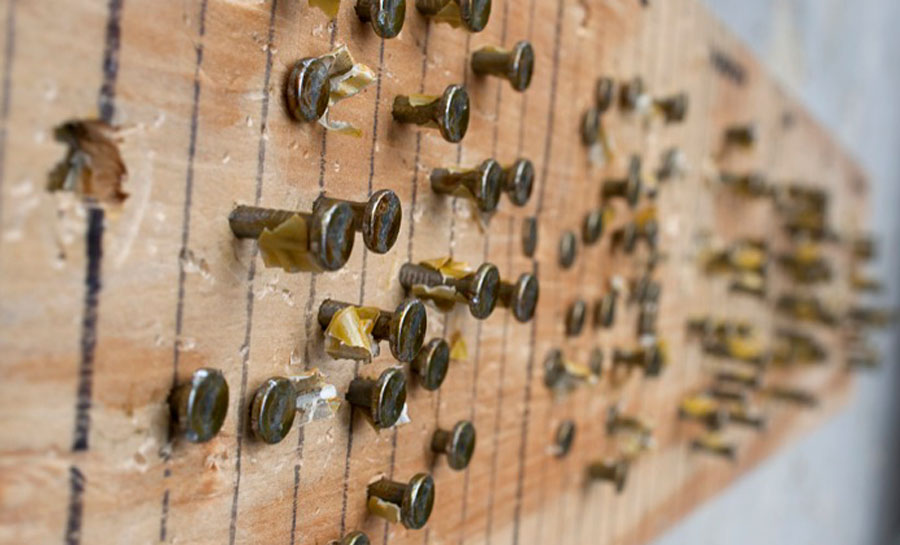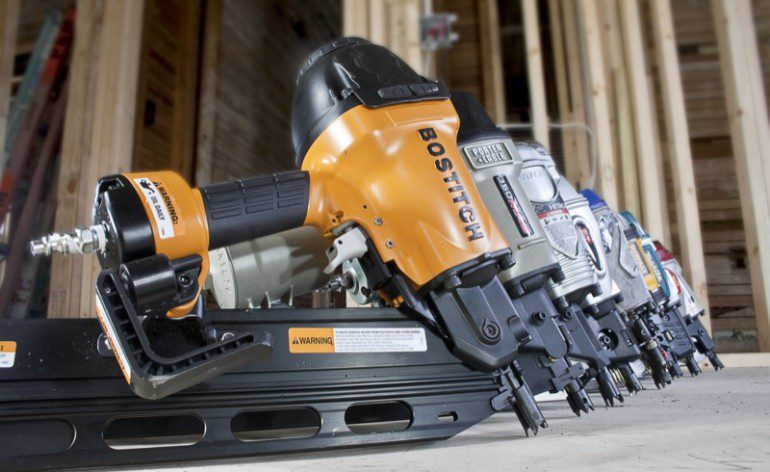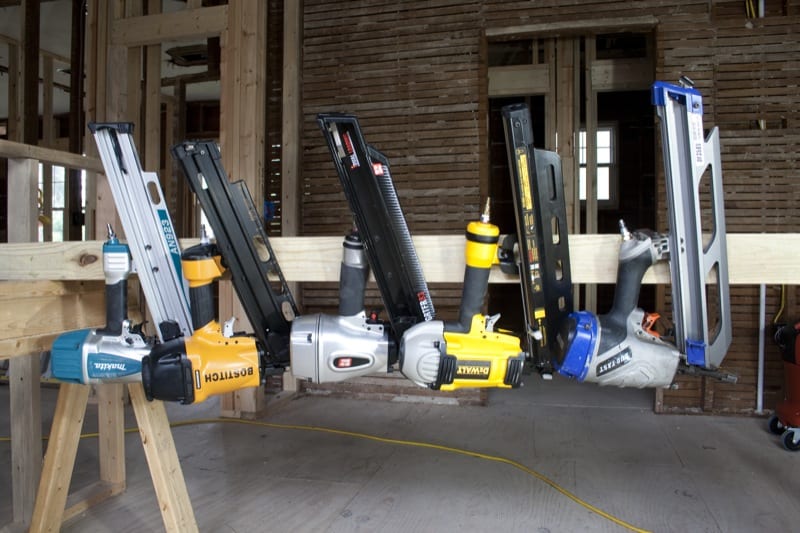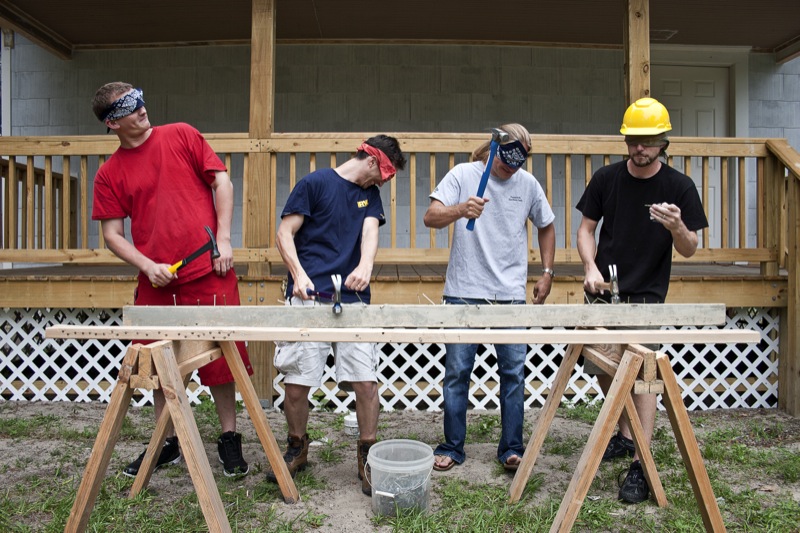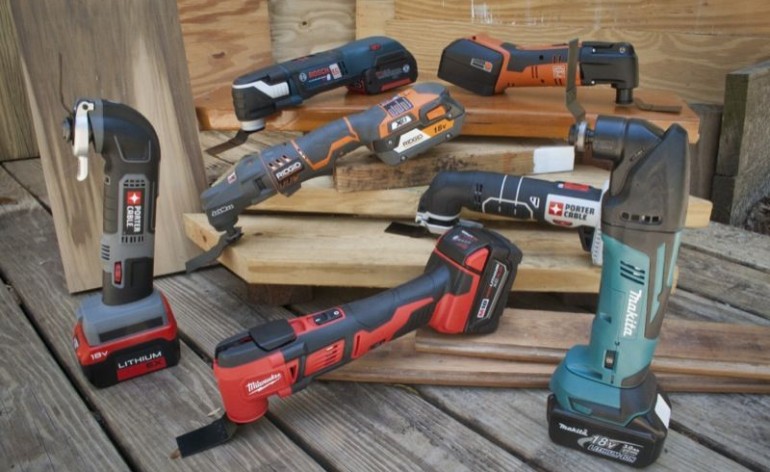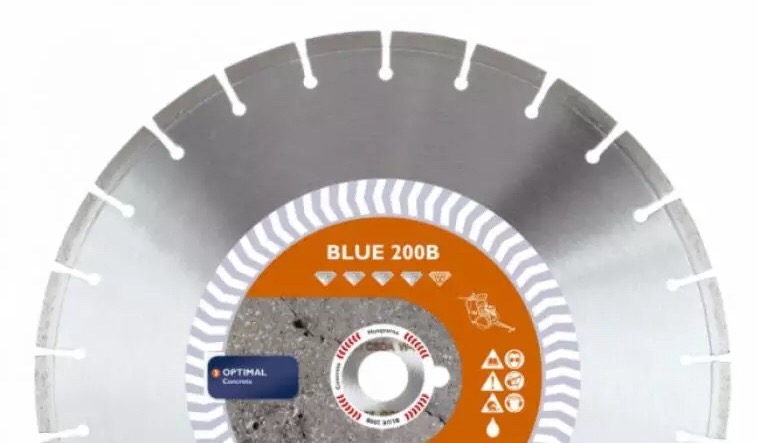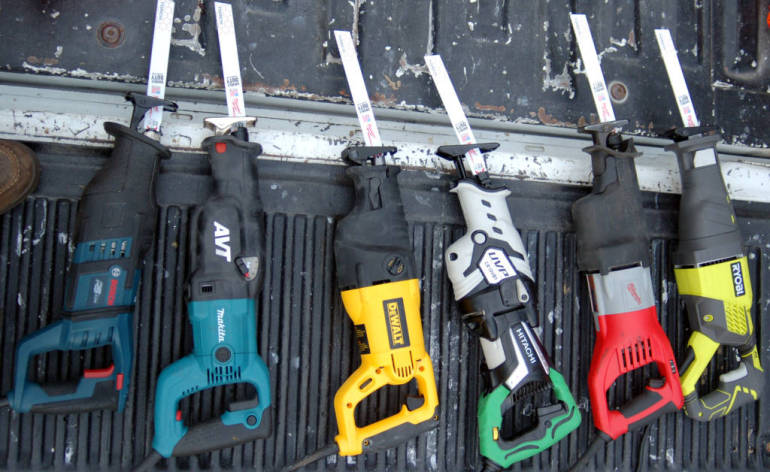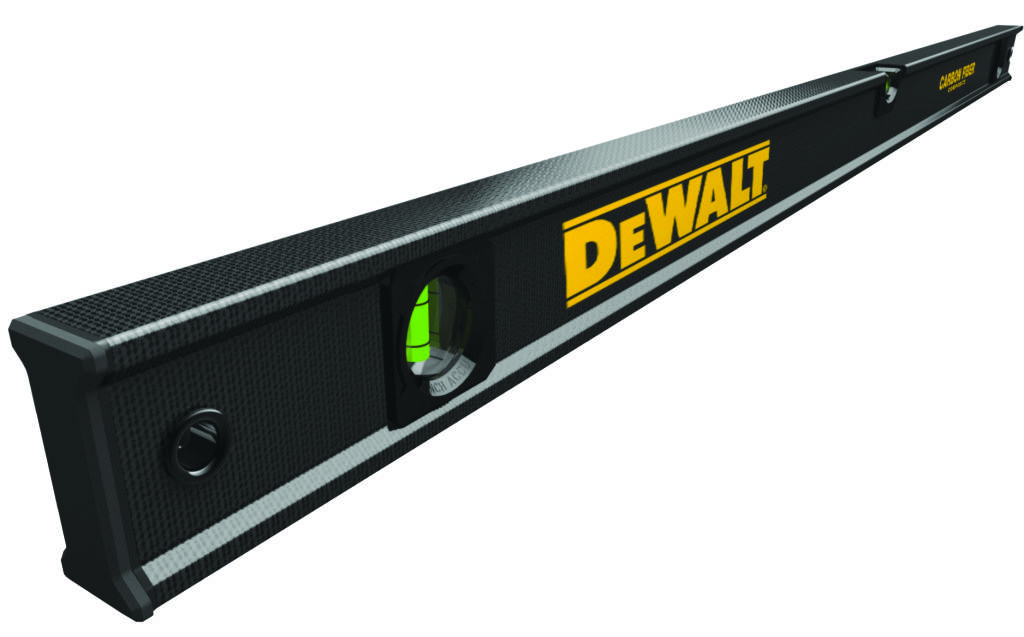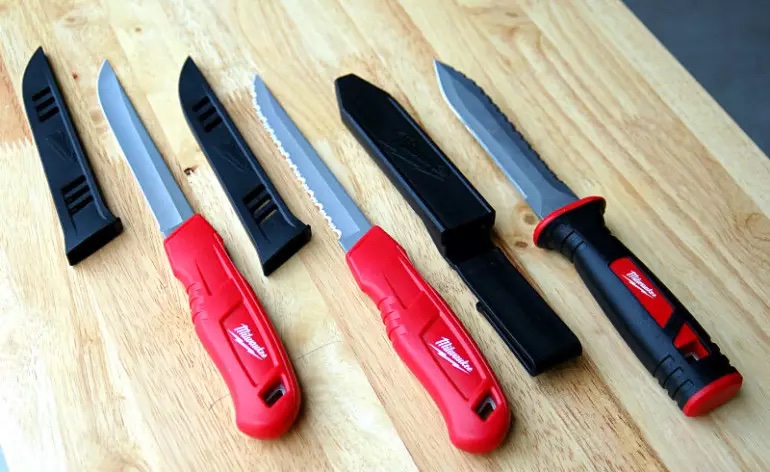Ed's Note: This comprehensive tool review is reprinted with permission from ProToolReviews.com, a comprehensive tool review website, as the name infers. If you are a tool junkie, you should go there and dig through their ditches. There's a lot.
I am in the middle of rebuilding a 90 year old home, and I’ve really begun to grow in my appreciation of the amount of work that it must have taken to frame a structure back then. It was the early days of electricity, so power tools were in limited supply, and there were certainly no portable air compressors to power pneumatic tools.
I can only imagine the builders of yesteryear as being barrel-chested men with burly biceps, swinging hammers that were equally large.
Fast forwarding to now, my skinny little self really appreciates the progress we have made in developing tools to help us work smarter and not harder. Aside from the circular saw, arguably the next biggest advance in speeding up the building process would have to be the harnessing of compressed air to power framing nailers.
The first pneumatic nailers came out in the early 1950s and have since exploded to a tool segment with models covering every phase of the construction process—from rough framing all the way through to detailed finish carpentry. Finding the best framing nailer is important to me because I want a tool that will last and work efficiently for me.
Choosing a slice of the pneumatic pie
I wanted to give pneumatic nailers the attention they deserve, but I had to make some choices. To wrangle in the myriad products and options, I focused on framing nailers that use plastic collated 20-22 degree nails with full round heads.
The ten tools that are part of this roundup certainly have their own specialized features, but all share at least some of the same key design elements.
- All the nailers have extruded aluminum magazines that hold at least 60 nails (two full sticks).
- Accepted nail sizes range from 2″ to 3-1/2″ long, with .113″ to up to .162″ diameters in smooth or ring shanks.
- Each has a sliding safety system built right into the contact tip with some means of depth adjustment.
- A trigger is used to activate the firing of the nail with each having some method to change from bump (contact) mode to sequential fire modes.
Where the differences start to play out is in how the tools implement these and other features. As I work through this list of feature sets, I will typically just call out the model number once per product and then refer to just the brand names of the associated tool.
Since each manufacturer submitted only one product for review it should be easy to follow what tool we are talking about—plus you can think of it as being on a first-name basis.
Following is a breakdown of what I consider to be major features of pneumatic framing nailers.
Weight and Balance
There was just over a two pound spread in the weight of the ten nailers in this review.
The heaviest was the Makita AN923 at 9.4 pounds, and the lightest was the Hitachi NR90AE (S) at just 7.37 pounds. A very close second and third lightest goes to the Max SuperFramer SN883HR2 (7.47 lbs.) and the GripRite GRTFR83 (7.49 lbs.) Porter-Cable’s FR350MAG, despite its large size, is also a good choice since it is in the sub-eight pound range.
Balance goes hand in hand with weight, and as you can imagine, lighter overall weight typically resulted in better balance. All the nailers tended to have a slight bias toward the head of the tool when holding onto the handle, and this is to be expected given the tool’s shape—and the fact that you want the weight to be on the striking side.
The lightweight tools quickly became favorites because they felt nimble, especially when having to do overhead work or anything that involved using the tool for hours at a time.
Metal Strike Plates
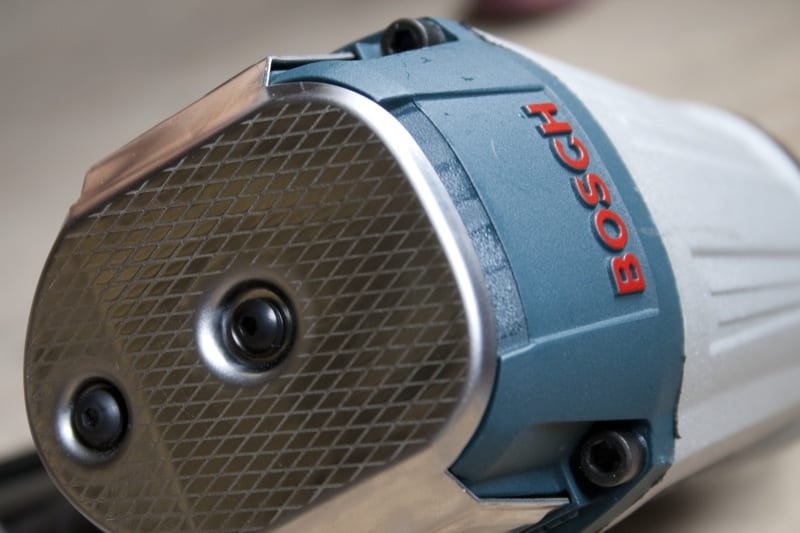
Anyone that has been out in the field long enough knows that you do not always have the right tool at hand for the job. Sometimes that hammer is just out of reach, and you really need to bump a stud over a bit to get it to line up properly.
What normally happens is the nail gun becomes an impromptu hammer. So Bosch, Duo-Fast, Grip-Rite, Hitachi, Makita and Max made the rear air deflector out of metal—not plastic.
The best framing nailers have metal housings that can take slight blows to the back without damaging the nailers. The design of the Bosch SN350-20F and the Hitachi are among the best I think. Their strike plates are so large they cover the entire backside of the tool and seem really purpose-built to take a solid hit.
Given how framing nailers are used in the field, why any manufacturer puts plastic on the back of their nailers at this point is beyond me.
Rafter Hooks
Being able to temporarily hang up a nailer when getting rafters or trusses into place is handy, and the Bostitch, DeWalt, Duo-Fast, Grip-Rite and Makita tools all come with factory-provided hooks.
The composition of these hooks vary from plastic, like those found on the DeWalt and Bostitch, to metal models on the Duo-Fast, Grip-Rite and the Makita. The two models with plastic hooks seem sturdy enough, but this is a high stress part, and it will be interesting to see how long they last.
All the models except for the Duo-Fast DF350S allow for the hooks to be quick-folded or pivoted out of the way without tools. The Duo-Fast is rigidly mounted, but it can be manually rotated by loosening a screw and locking it down into either left or right side locations.
My favorite is the GripRite since it is the largest and sturdiest, and it’s also the easiest to position or put away.
Depth of Drive Adjustment
This is one area that differs greatly from manufacturer to manufacturer. The models ranged from having small and large-sized thumb wheels to push-buttons and even tips that need to be adjusted with Allen wrenches.
I greatly favor the concept that a tool is better off if it doesn’t need yet another tool to make small adjustments.
Therefore the Porter-Cable and the SureBonder 9772 do not make my list of favorites in this department. Both of these tools need a Allen wrench to adjust the depth of drive (though the Porter-Cable at least provides a convenient place to store the wrench on the tool).
The Bostitch F21PL and DeWalt D51850 nailers are interesting in that they use a sort of push button system to make changes to the depth. Another notable item on the Bostitch is the removable tip which can be replaced with an included positive placement metal connector nail tip.
The remaining six tools all use a thumb wheel to adjust the depth. The three easiest to change, even with gloves on are the GripRite, Max and the Makita. The Bosch, GripRite and Hitachi all tended to be slightly more stubborn and required a little extra effort.
Nail Loading
Regardless of whether you prefer top-loading or rear-loading nails (and if you cannot decide, consider the GripRite which offers both methods), the most important thing to keep in mind is that when loading just one stick of nails (half a magazine) it’s best not to let the nail pusher “fly” forward—this can damage the plastic collating on the nails, which can cause jams.
This leads us into our next feature.
Jam Clearance
Only two of the nailers, the Bosch and the Porter-Cable offer quick ways to remove the magazine to clear a jam.
The Bosch is the quickest and easiest since it uses a simple lever at the base of the handle that, when pivoted, releases the magazine from the head—no tools required and no pieces to lose.
The Porter-Cable is almost as quick but requires spinning a knob until the release bolt is clear of the bracket, freeing the magazine. All the other nailers require extra tools to remove their magazines.
Dry-fire Lock Out
The DeWalt, Duo-Fast, Grip-Rite, Makita and SureBonder all feature a dry-fire lock out feature. For guys that do a lot of rapid nailing, like in the installation of wall sheeting and sub flooring, the dry-fire lockout is helpful to make sure you do not miss fasteners in the nailing patterns.
It also ends up making you more productive since you waste less time blowing through a series of blanks. Most seasoned framers can recognize the different sound made by the nailers which lack this feature, but it’s still an advantage.
While not a deal breaker, this feature is fast becoming a new “standard” on many current models.
Contact Trip and Sequential Trigger
All the nailers in this review offer two trigger options.
The first is the contact trip (“bump fire”) trigger which allows the tool to fire any time the trigger and the tip of the nailer (contact element) are both depressed. In this mode, the trigger can be held down continually to allow bump or bounce nailing.
The second (and safer) option is the sequential trigger also know as single fire mode. This requires the tip of the nailer (contact element) to be depressed and the trigger pulled before a nail will fire. After each shot, the trigger must be release and pulled gain to fire another nail. This more deliberate trigger work helps to avoid inadvertent discharge of nails.
Historically the contact trip trigger mechanism carries twice the risk of injury than the sequential trigger—even after considering experience and training. Accidental firings are most common after the recoil or bounce of the nailer with contact trip triggers. (This is according to OSHA and, unfortunately, my own experience.)
All the nailers come from the factory configured to work in the sequential trigger mode. The Bostitch and DeWalt nailers actually need full trigger swaps to make them work in contact trip mode. The rest of the tools all have onboard switches that make going back and forth between the two modes as easy as flipping a switch.
The easiest tools to switch over are the Hitachi, Makita and SureBonder.
Hitting the Deck—Testing the Best Nailers in the Field
To set up for testing we first installed standard 1/4” quick release air couplings on the tools that did not include them. (I highly recommend a good quality swivel connector.)
Of the ten framing nailers tested, only four manufacturers saw the value in having the connectors included and preinstalled. For a part that cost pennies, this seems like a no-brainer. Besides, these connectors can be easily swapped out by the user if it doesn’t fit their system.
We next set each nailer’s depth of drive adjustment to the highest setting so that it would drive the nail as deep as possible. Since two of the nailers come standard with sequential fire triggers installed (Bostitch and DeWalt), I went ahead and set the fire mode of the rest of the nailers to the same mode.
For all the testing I used a 33 gallon fast recovery air compressor so that air supply would not be an issue during rapid fire testing. Line pressure was set to 105 PSI which I found to be a good high-end common denominator gave the collective specifications of all the nailers involved.
Sub Floor Test
For this test 2-3/8” ring shank nails were used to fasten 3/4” sub floor plywood to yellow pine floor joists. The objective was to see if there were any nails left standing after rapid-firing the nails into place.
All the nailers were given a magazine full of nails (two sticks). After striking chalk lines over the joist, the tools were put to the test by shooting the full magazine of nails as quickly as possible.
As I worked through dozens of magazines, what became clear was the importance of tool efficiency and air pressure.
When a nailer failed to drive a nail all the way into the decking, it was because of a drop in line pressure when the compressor was attempting to keep up. When the air pressure dropped, so would the nail’s depth of drive.
The Max SuperFramer and the SureBonder were two nailers in particular that had a difficult time driving nails quickly when the air got a little low. While this is not necessarily the fault of the nailer when the compressor cannot keep up, it does speak to the efficiency of the mechanics of the tool. It also shows that you need to know your tool and the maximum effective speed at which it will work with your particular air compressor for best results.
Toe Nail Test
While some salty carpenters will argue that toe nailing is not a proper framing method, the reality is that it happens a lot out in the field. Sure, I love to pre-build all my walls, but there are simply times that for one reason or another I have to build them in place during a renovation.
Rather than just looking at the tips to see if they have side barbs or other means to grip the wood, I gave each nailer a good try at toe nailing using 3-1/4” x .131” bright framing nails. Some of the nailers had a more pronounced side barb on the tip, and all the tips except for the Duo-Fast had either five or six points to facilitate different angle engagements of the nailer’s contact tip to the wood.
Interestingly, all the nailers accept for the Duo-Fast did a fine job of toe nailing. The tip of the Duo-Fast is actually without any side barbs, which makes it slightly more tricky to get consistently-placed angled nails in the bottom of 2×4’s.
Conventional Framing Test
Given my involvement in several home renovations, finding opportunities to test pneumatic nailers on framing applications was not terribly difficult.
At one point I constructed several sections of 2×4 walls using spruce to evaluate the ergonomics of each nailer, view the tip sight lines and, of course, verify each nailer’s ability to drive nails.
- I did not have a single tool that was not able to drive 3-1/4” x .131” bright nails either flush or below the surface. All the pneumatic nailers performed as expected without leaving a single nail that required an extra whack with my hammer.
- The sight lines on all the nailers were also very good. Since all the nailers follow nearly identical design principals on the contact tips, putting nails exactly where you want them is something that never requires a learning curve—even when going to a new tool.
Having encountered so many products that delve into multiple applications and uses, it’s nice being able to test a tool that is designed to do simply one thing—drive nails!
Tough Material Testing
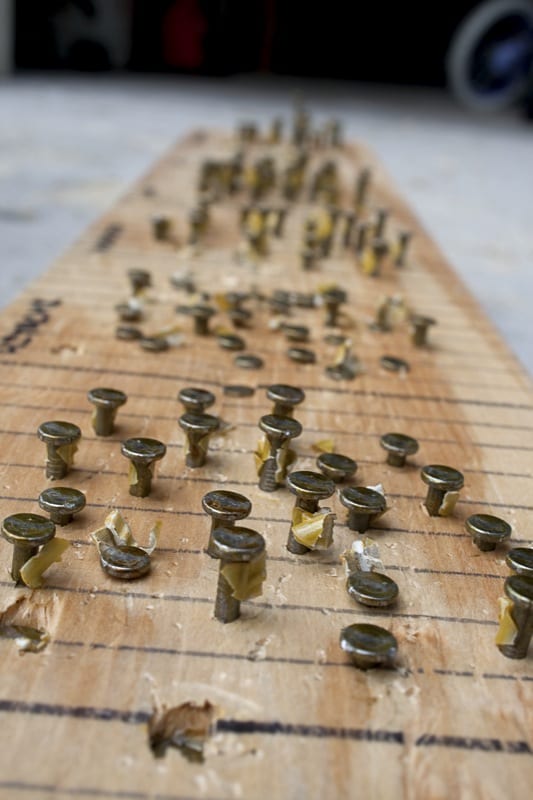
One thing I knew I wanted to test was how hard each of these pneumatic framings nailers could truly hit. I figured not all the tools had the guts to sink nails into very challenging materials like engineered wood framing members.
The best framing nailers would sink them further—and more consistently. To simulate this for testing I laminated five layers of 3/4” sub floor plywood together to get a block nearly 4” thick. Anyone who has had to nail into LVL (laminated veneer lumber) can understand why you may want to know how hard a pneumatic nailer can actually hit.
I loaded a single stick of 3-1/4” x .131” nails and placed the test block on a concrete floor to eliminate material bounce. Each shot was deliberate and stabilized by using two hands on the nailer.
The goal: sink all the nails in the magazine as deeply as possible.
The results of this exercise was the most telling out of all the testing that I did, but by no means should they be construed as my final answer on choosing a nailer. In fact, none of the nailers tested were able to drive every nail flush every time. The results fell into three main categories.
- The DeWalt, Max SuperFramer and the SureBonder had the toughest time driving the nails and left most them sticking out between 1/2” to 3/4” above the surface of the wood.
- The next group of nailers had mixed success, driving some of the nails flush while leaving others 1/4” to 1/2” above the surface. These were the Bosch, Duo-Fast, GripRite and Makita.
- The hardest-hitting nailers were the Bostitch, Hitachi and Porter-Cable, which drove most nails flush with just a few that bumped up 1/4” or less. The Bostitch displayed the most power and ability in this test since every nail it fired went below the surface.
Conclusion
So which is the best pneumatic framing nailer and how do you pick one? I think there are several key factors, but at the top of my list is performance and value.
Therefore I would pick the Hitachi NR90AE (S) as my top choice.
- Lightest weight
- Second least expensive
- Second longest warranty
- Among the top three in my tests
With that said, it lacks the dry-fire lockout feature and doesn’t come with a rafter hook. To me, the lack of these features doesn’t outweigh the overall value or performance. You may disagree, and that is why this is a subjective review open to interpretation.
As a second choice I would pick the Grip-Rite GRTFR83. It’s also very lightweight, offers flexible magazine loading options, dry-fire lockout and has one of the nicest rafter hooks out there.
The Bostitch F21PL is also a good contender with an amazingly long warranty, tons of power, built-in rafter hook and other great features. Plus it hits hard—really hard.
Finally, if you want light and compact, it’s very hard not to be attracted to the Max SN883RH2.
Of course I cannot ignore the fact that all the full head framing nailers really tested well in doing the job for which they are designed. All these tools will let you quickly and adequately frame a house. In the end, if you are driving home nails, there are very few losers in this category, and the final choice for your next nailer is going to weigh heavily on your perception of value and the features that you find most important.
Tool by Tool
Bosch SN350-20F
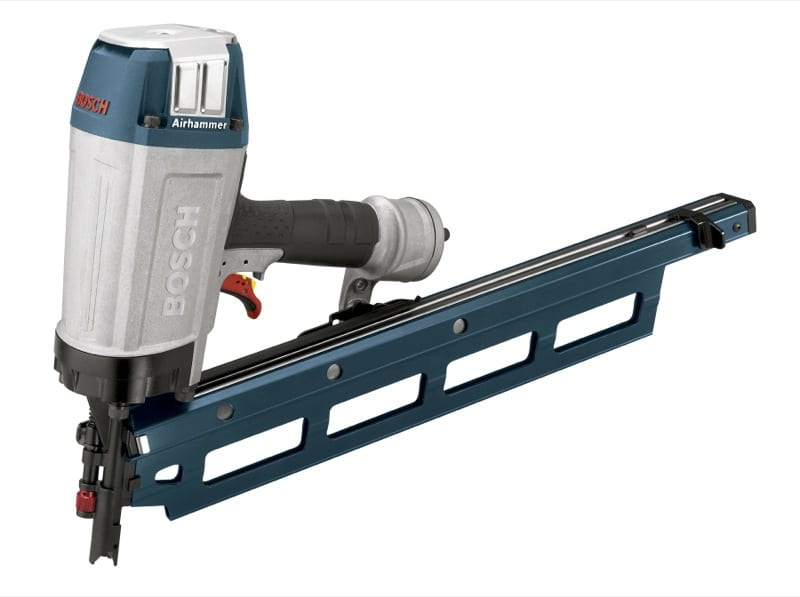
The SN350-20F is Bosch’s first entry into the framing nailer segment—and a pretty decent effort at that.
The quick-detach magazine provides excellent jam clearance, and the built-in trigger mode is easy to change. The overall body of the tool is much slimmer than all the other tools in the review. This is thanks to some nifty “Full Force” technology happening within that eliminates the need for a full return air chamber.
Appearances are deceiving, though, because this nailer is the second heaviest in the group. Perhaps in the future iterations, a dry-fire lockout and a rafter hook will be made standard.
- Pro: Metal strike plate, Quick release magazine
- Con: Heavy, No dry-fire lockout, Small and tight depth adjustment thumb screw
- Price: $289
- Verdict: A great start and solid performer with some room to grow in future iterations.
Bostitch F21PL
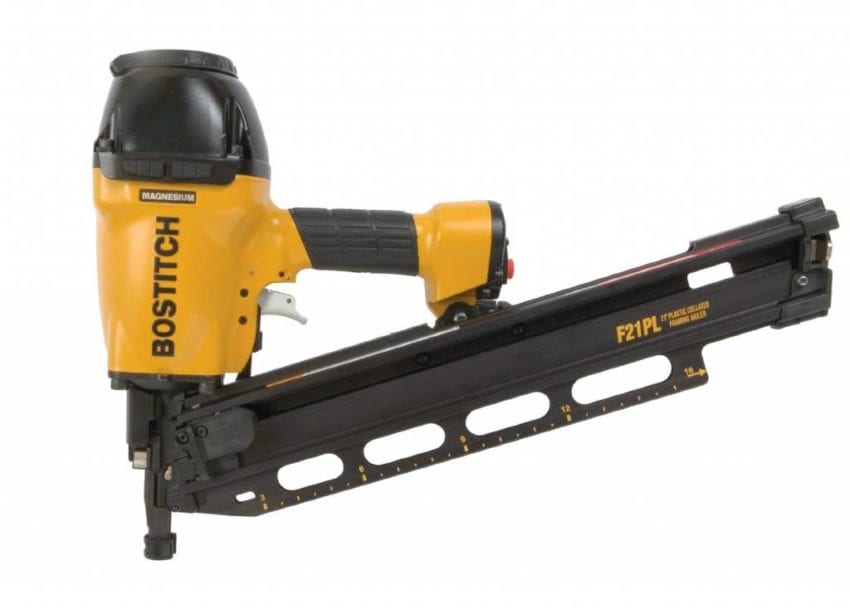
Out in the field the Bostitch F21PL is a common sight. Many contractors have been depending on them for years. This is for good reason, too, since it is a feature-rich nailer that offers one the longest warranties in the business.
Not only is the street price reasonable, the nailer actually packed the hardest punch in our dense-material torture test—the only tool to sink every nail. One of my favorite features are the swappable tip that allows you to go from framing to a positive placement tip made for installing metal connector nails.
To swap from sequential fire mode to contact trip, a trigger swap is in order, however, which can be a pain because small parts are involved.
- Pro: Swappable tips for metal connectors and framing applications, Hanging hook, 7-year warranty
- Con: Trigger swap needed for contact fire mode, Plastic rafter hook
- Price: $219
- Verdict: Fairly-priced powerhouse that is packed with features.
DeWalt D51850
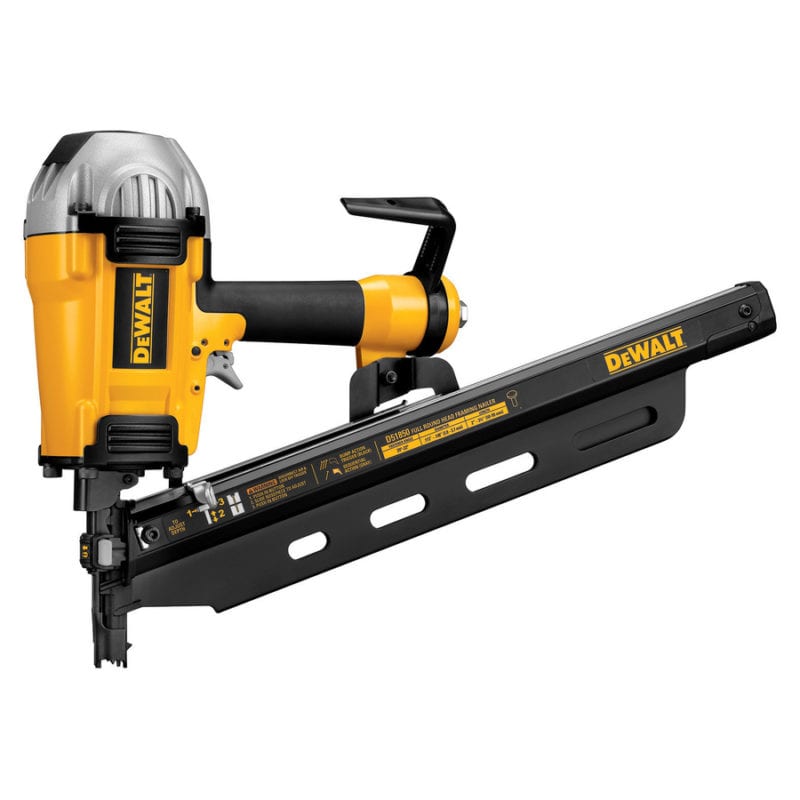
In a sea of aluminum-colored nailers, the DeWalt stands out with its bold familiar colors that I see on many job sites. The brand has certainly built a reputation out in the field with the guys that use their tools every day.
The D51850 nailer will not disappoint the company’s stalwart fans. With a built-in rafter hook, dry-fire lockout and one of the easiest to change depth adjustments, I found many reasons to like this nailer.
A trigger swap is necessary to change from sequential fire to contact trip modes which are a minor inconvenience when compared to the simple switch found on many of the other models tested.
We would also like to see the next generation eliminate the rear plastic exhaust air deflector for a metal plate so that it can take a blow here and there.
- Pro: Hanging hook, Easy depth adjustment, 3-year warranty
- Con: Plastic exhaust air deflector, Dry-fire lockout leaves too many nails in the magazine
- Price: $219
- Verdict: The Tonka truck style and great build quality that many have come to expect.
Duo-Fast DF350S
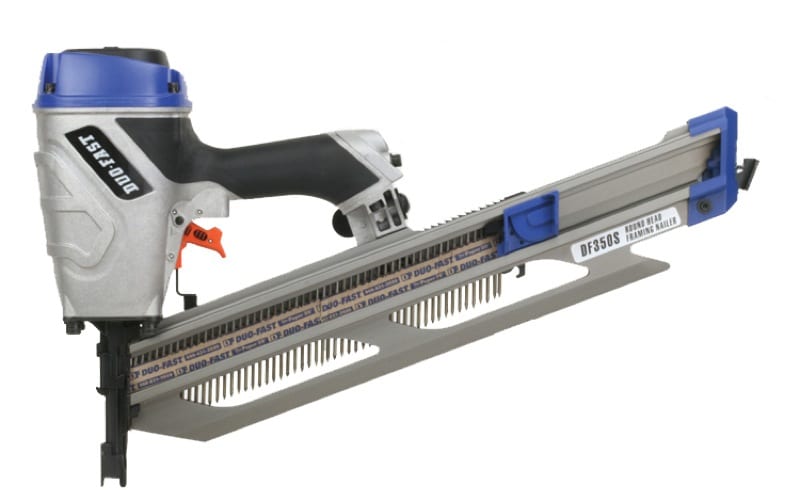
The Duo-Fast DF350S is a sturdy nailer that hits hard.
The rafter hook is very sturdy and adjustable to either side. The absence of side barbs on the contact tip is puzzling, and it can make for some extra work in toe nailing.
The solid rear metal housing makes this back of this nailer safe to use as a framing material adjuster when needed.
All in all, this a solidly-built framer with almost no plastic to be found anywhere on the tool.
- Pro: Great rafter hook, Solid metal back plate, Dry-fire lockout
- Con: Expensive, no side barbs on contact tip for toe nailing
- Price: $299
- Verdict: Solid framer that can take job site abuse.
GripRite GRTFR83
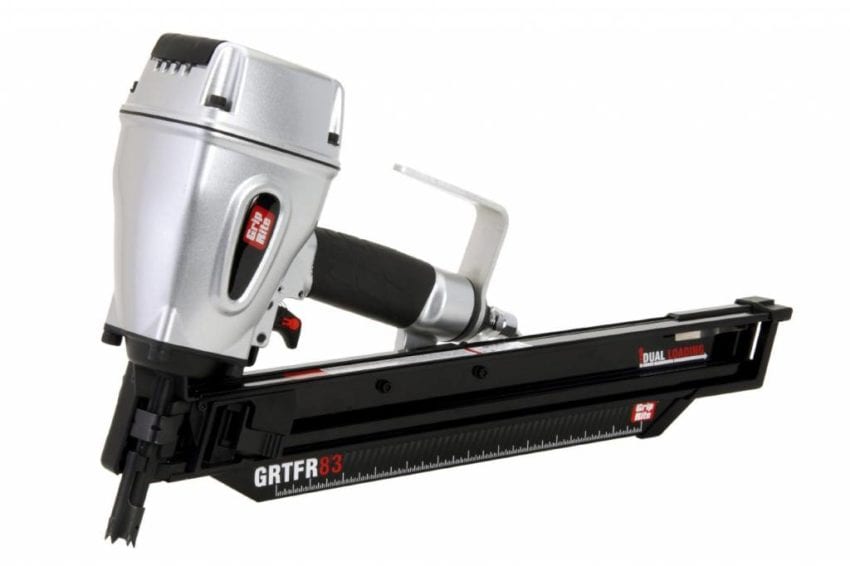
With everything you like and need built right in, the GripRite GRTFR83 aims to please.
The rafter hook is among my favorites—it’s large, metal, and it rotates around easily. It is also the only dual-load magazine, allowing you to drop in nails from the top or slide them in from the rear.
It also has a dry-fire lockout. The balance is great thanks to it being the third lightest tool in this review.
This nailer has everything you need and want.
- Pro: Rafter hook, Lightweight, Dual magazine loading, Dry-fire lockout
- Con: None to report
- Price: $239
- Verdict: A well thought out nailer with all the options and features you need and want.
Hitachi NR90AE (S)
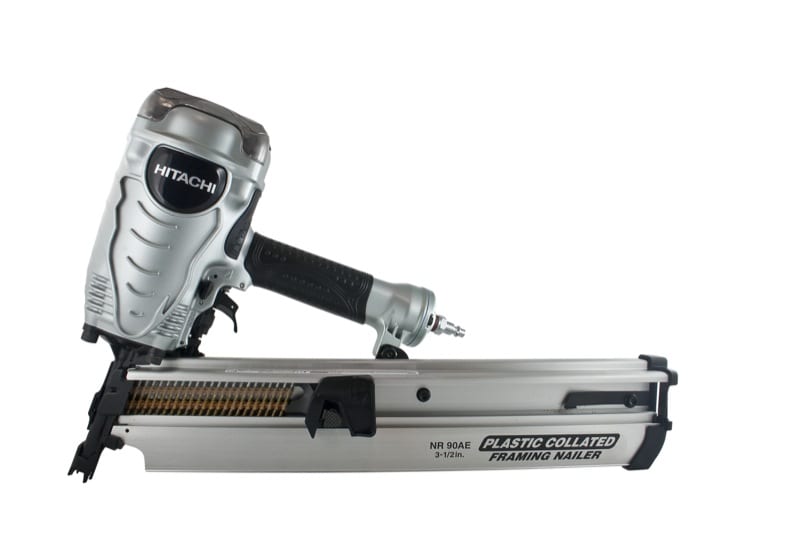
Value and performance are two things that can be tricky to balance when it comes down to designing a tool for real world use. Hitachi has done a stellar job of covering both with the NR90AE (S).
With the lightest weight out of all the tools in this review, the second lowest street price and one of the hardest hits, this nailer is an easy choice. Factor in the long 5-year warranty, and I can almost overlook the fact that it lacks a dry-fire lockout feature or a rafter hook.
- Pro: Lightweight, Low cost, Hard hitting, Long warranty
- Con: No dry-fire lockout or rafter hook
- Price: $179
- Verdict: The lightweight value leader that doesn’t compromise performance.
Makita AN923
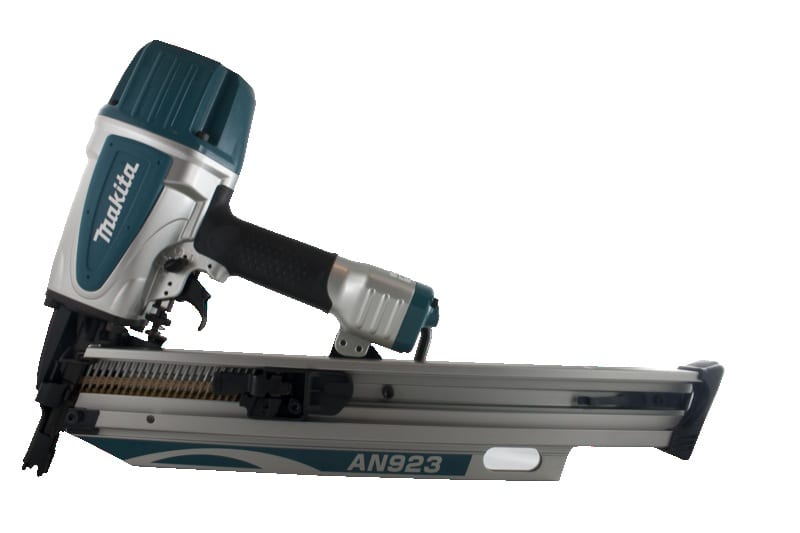
The Makita AN923 nailer gains the distinction of being the heaviest and most expensive tool in the review, weighing in at nearly a pound more than the other nailers. The extra weight makes this nailer feel very off-balanced.
Offsetting that are several great features, including a metal exhaust strike plate, dry-fire lockout, a metal rafter hook and a switch to change trigger modes almost instantly.
- Pro: Rafter hook, Dry-fire lockout
- Con: Heavy, Expensive, Flimsy plastic cap on the nail-loading end of the magazine
- Price: $320
- Verdict: Many great features and solid performance, but very heavy and one of the more expensive tools.
Max SuperFramer SN883RH2
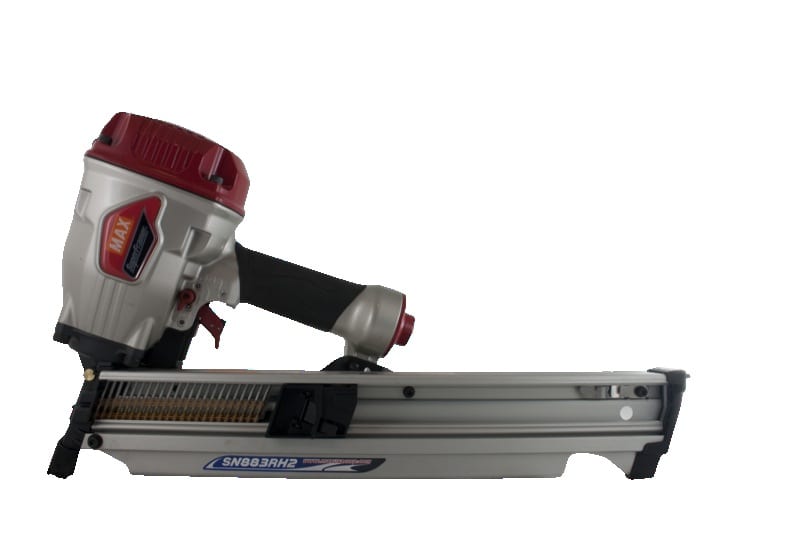
If having the most compact and lightweight framing nailer is your goal, then the Max SuperFramer SN883HR2 is the nailer for you.
With a body that is nearly an inch shorter than all the other nailers, you can be sure to squeeze into tight spaces with ease. This framing nailer quickly became a favorite because of its smaller size and great balance.
Swapping the trigger from sequential to contact involves removing a pin, but it is not a big deal for those of us who will appreciate the dual mode firing configuration.
- Pro: Lightweight, Compact
- Con: No dry-fire lockout
- Price: $219
- Verdict: This compact, lightweight tool makes for a favorite.
Porter-Cable FR350MAG
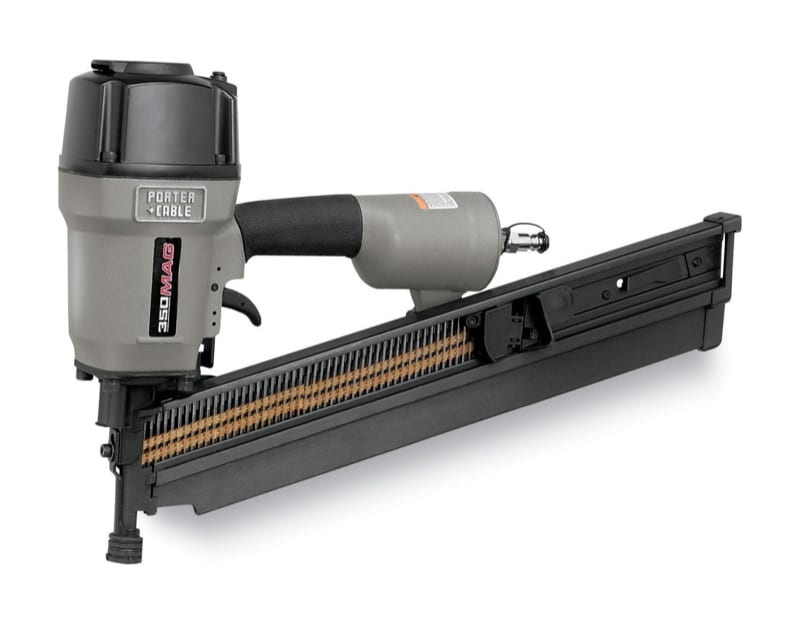
Do not let the large size of the Porter-Cable FR350MAG fool you because this nailer is actually one of the lightest in the group.
It’s also one of the hardest hitting and one of the few nailers to sink nails all the way in our dense material testing. We wish there was a tool-less depth of drive adjustment, but thankfully there is a Allen wrench stored on the magazine for this purpose.
Oddly enough, while they make depth adjustment a tad difficult, the magazine itself features a tool-less removal system for quick clearing of jams, and dry-fire lock out is included.
- Pro: Quick release magazine, Lightweight, Hard hitting
- Con: No tool-less depth of drive adjustment
- Price: $289
- Verdict: Big boy nailer for hard-hitting applications.
SureBonder 9772
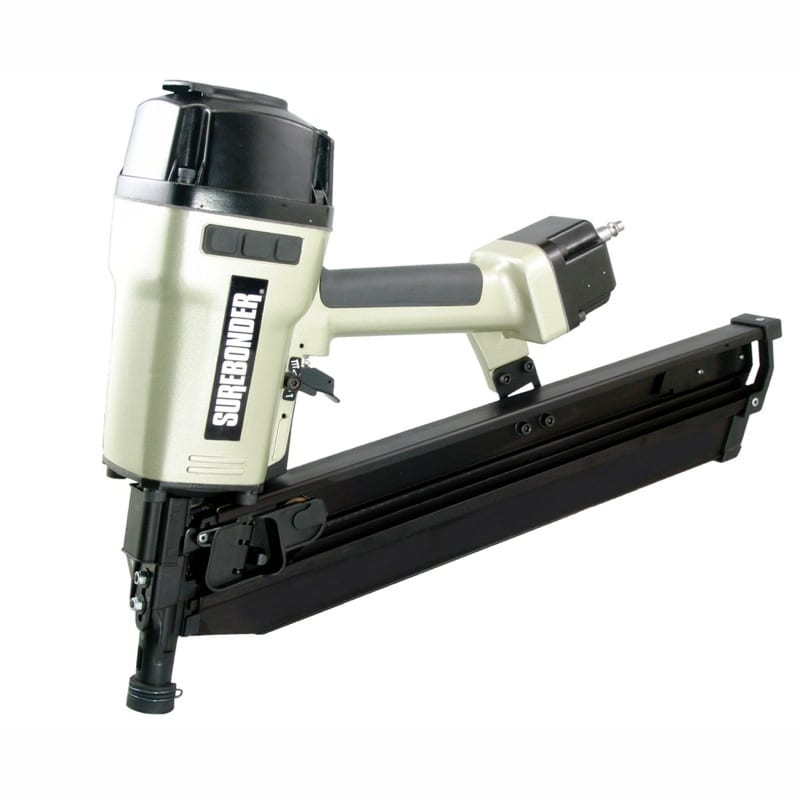
If cost is your chief consideration, then the SureBonder 9772 is going to grab your attention.
Even at its low price, features still abound. There is a quick switch to change from sequential to contact tip modes, dry-fire lockout and an exhaust air deflector that rotates to keep the air from hitting you in the face.
This nailer is also among the more lightweight tools we looked at.
- Pro: Low cost, Dry-fire lockout, Lightweight
- Con: No tool-less depth of drive adjustment, Short warranty
- Price: $119
- Verdict: Price leader that still manages to offer decent performance and features.
